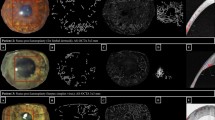Abstract
The process of corneal neovascularization induced by alkali burns was periodically observed with a newly developed macroscope. The central corneas were burned using filter discs measuring 6 mm in diameter that had been immersed in 1 N NaOH. At 0, 1, 3 and 7 days and at 2, 3 and 4 weeks after injury, the corneas were observed with the macroscope and then examined histologically. At 1 day post-burn, the limbal vascular plexus was engorged but no new vessel formation was detected. By 3 days, many vascular sprouts had arisen from the limbal vascular arcade. At 7 days, the vascular sprouts grew and became fine new vessels. At 2 weeks, the new vessels lengthened further to the central cornea. At 3 weeks, trunk vessels extended and branched like a vascular tree. Blood in the trunk vessels appeared to flow slowly to and fro. The ends of the vessels swelled in a fusiform shape on the application of slight pressure of the macroscope probe. Histological examination revealed that the ends of the vessels consisted of single vascular endothelial cells and the trunk vessels were covered by pericytes. By 4 weeks, the branch vessels around the burned lesion had degenerated and collapsed. Thus, our in vivo study using the new macroscope not only clarified the process of corneal neovascularization from the early to the regressive phases but also provided some valuable new information.
Similar content being viewed by others
References
Beck DW, Hart MN, Cancilla PA (1983) The role of the macrophage in microvascular regeneration following brain injury. J Neuropathol Exp Neurol 42:601–612
BenEzra D (1978) Mediators of immunological reactions: function as inducers of neovascularization. Metab Ophthalmol 2:339–341
Burger PC, Chandler DB, Klintworth GK (1983) Corneal neovascularization as studied by scanning electron microscopy of vascular casts. Lab Invest 48:169–180
Cogan DG (1949) Vascularization of the cornea: its experimental induction by small lesions and a new theory of its pathogenesis. Arch Ophthalmol 41:406–416
Epstein RJ, Hughes WF (1981) Lymphocyte-induced corneal neovascularization: a morphological assessment. Invest Ophthalmol Vis Sci 21:87–94
Folkman J, Merler E, Abenathy C, Willams G (1971) Isolation of a tumor factor responsible for angiogenesis. J Exp Med 133:275–288
Fromer CH, Klintworth GK (1975) An evaluation of the role of leukocytes in the pathogenesis of experimentally induced corneal neovascularization: I. Comparison of experimental models of corneal vascularization. Am J Pathol 79:537–550
Fromer CH, Klintworth GK (1976) An evaluation of the role of leukocytes in the pathogenesis of experimentally induced corneal vascularization: III. Studies related to vasoproliferative capability of polymorphonuclear leukocytes and lymphocytes. Am J Pathol 82:157–166
Klintworth GK (1977) The contribution of morphology to our understanding of the pathogenesis of experimentally produced corneal neovascularization. Invest Ophthalmol 16:281–285
Klintworth GK, Burger PC (1983) Neovascularization of the cornea: current concepts of its pathogenesis. Am J Pathol Int Ophthalmol Clin 23:27–39
Lutty GA, Lui SH, Prendergast RA (1983) Angiogenic lym-phokines of activated T-cell origin. Invest Ophthalmol Vis Sci 24:1595–1601
Matsuhashi K (1962) Experimental study on the corneal neovascularization: II. Electron microscope observation on the corneal vascularization. Acta Soc Ophthalmol Jpn 66:942–952
Maurice DM, Zauberman H, Michaelson IC (1966) The stimulus to neovascularization in the cornea. Exp Eye Res 5:168–184
McCracken JS, Burger PC, Klintworth GK (1979) Morphologic observations on experimental corneal vascularization in the rat. Lab Invest 41:519–530
Ormerod LD, Abelson MB, Kenyon KR (1989) Standard models of corneal injury using alkali-immersed filter discs. Invest Ophthalmol Vis Sci 30:2148–2153
Polverini PJ, Cotran RS, Gimborne MA Jr, Unanue ER (1977) Activated macrophages induce vascular proliferation. Nature 269:804–806
Schanzlin DJ, Cyr RJ, Friedlaender MH (1983) Histopathology of corneal vascularization. Arch Ophthalmol 101:472–474
Sholley MM, Ferguson GP, Seibel HR, Montour JL, Wilson J (1984) Mechanisms of neovascularization: vascular sprouting can occur without proliferation of endothelial cells. Lab Invest 51:624–634
19.Sugiura S, Matsuda H (1969) Electron microscopic studies on the corneal neovascularization. Acta Soc Ophthalmol Jpn 73:1208–1221
Yamagami I (1969) Electron microscopic studies of the cornea: I. The mechanism of experimental new vessels formation. Acta Soc Ophthalmol Jpn 73:1222–1242
Author information
Authors and Affiliations
Rights and permissions
About this article
Cite this article
Hayashi, K., Ishibashi, T. In vivo observations on experimental corneal neovascularization with a newly developed macroscope. Graefe's Arch Clin Exp Ophthalmol 229, 473–479 (1991). https://doi.org/10.1007/BF00166313
Received:
Accepted:
Issue Date:
DOI: https://doi.org/10.1007/BF00166313




